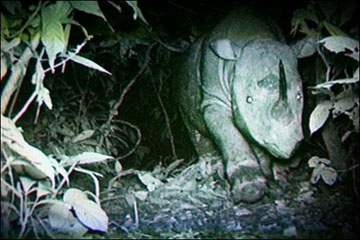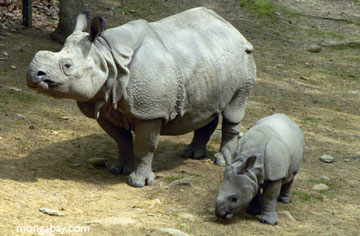Scientists capture video of rare Borneo rhino
Scientists capture video of rare Borneo rhino
mongabay.com
April 24, 2007
WWF has captured video footage of the rare Borneo rhino. There are only 25-50 of the rhino left in the wild on the island.
Video from a “camera trap” shows the animal eating, walking to the camera and sniffing the equipment. It is first time the beast’s behavior in the wild has been captured on film.
These are very shy animals that are almost never seen by people,” said Mahedi Andau, director of the Sabah Wildlife Department. “This video gives us an amazing opportunity to spy on the rhino’s behaviour.”
The Borneo rhino is highly endangered by widespread habitat destruction and poaching for its horn, which is used for ceremonial dagger handles in the Middle East and as medicine in some Asian countries. Today the rhinos are so rare there are concerns that individuals are so isolated they “may rarely or never meet to breed” according to WWF.

A video grab released by WWF Malaysia on shows a rare two-horned Borneo rhino in the Malaysian rainforest of Sabah state in Borneo. Image courtesy of Stephen Hogg, WWF-Malaysia
Sumatran Rhinoceros (Dicerorhinus sumatrensis) at the WCS-run Bronx Zoo in New York. The Sumatran Rhino once lived throughout southeast Asia but today is only found in the rainforests on Sumatra, an island in Indonesia. The Sumatran Rhino is the smallest rhinoceros species, as well as the one with the most fur. There are only about 300 Sumatran Rhinos left in the world because of hunting and deforestation. Photo by Rhett A. Butler
|
“The photos and video footage will be used to determine the condition of the rhinos in the wild,” said Raymond Alfred, project manager for WWF’s Asian Rhino and Elephant Action Strategy (AREAS). “But we have to realize that these rhinos could face extinction in the next ten years if their habitat continues to be disturbed and enforcement is not in place.”
The rhinos of Borneo, the world’s fourth largest island, are classified as a separate subspecies from the Sumatran rhino (Dicerorhinus sumatrensis harrissoni(), another critically endangered species. WWF says that the decision of the three governments that share the island of Borneo — Indonesia (Kalimantan), Malaysia (Sabah and Sarawak), and Brunei — to protect a large area dubbed the “Heart of Borneo” in the rugged central part of the island may offer new hope for the species.
“The Heart of Borneo is one of the most biologically diverse habitats on earth and protecting this sanctuary could not be possible without the commitment and leadership of these three visionary governments,” said Carter Roberts, president and CEO of World Wildlife Fund, at the time of the announcement. “This declaration is a monumental success for conservation and for the millions of people who rely on Borneo’s natural resources for their very livelihood. Enacting sustainable practices in this region will help ensure its preservation for generations to come.”
View video here
Related
Borneo. Borneo, the third largest island in the world, was once covered with dense rainforests. With swampy coastal areas fringed with mangrove forests and a mountainous interior, much of the terrain was virtually impassable and unexplored. Headhunters ruled the remote parts of the island until a century ago. In the 1980s and 1990s Borneo underwent a remarkable transition. Its forests were leveled at a rate unparallel in human history. Borneo’s rainforests went to industrialized countries like Japan and the United States in the form of garden furniture, paper pulp and chopsticks. Initially most of the timber was taken from the Malaysian part of the island in the northern states of Sabah and Sarawak. Later forests in the southern part of Borneo, an area belonging to Indonesia and known as Kalimantan, became the primary source for tropical timber. Today the forests of Borneo are but a shadow of those of legend and those that remain are highly threatened by the emerging biofuels market, specifically, oil palm.
13 rare rhinos found in Borneo survey by WWF. World Wildlife Fund today released the results of a field survey from the island of Borneo which found that poaching has significantly reduced Borneo’s population of Sumatran rhinos, but a small group continues to survive in the “Heart of Borneo,” a region covered with vast tracts of rain forest. .
Eco-friendly palm oil could help alleviate poverty in Indonesia. Palm oil is quite obviously not a failure as a biofuel—it is derived from perhaps the most productive energy crop on the planet. A single hectare of oil palm may yield nearly 6,000 liters of crude biodiesel. In comparison, soybeans and corn generate only 446 and 172 liters per hectare, respectively. The problem with palm oil is not its yield, but how it is produced. Presently much of the world’s palm oil is coming out of the forests of Southeast Asia—increasingly in the biodiverse rainforests of Indonesia. Since demand for palm oil isn’t going to go away, Europe’s best approach is to convince Indonesian oil-palm producers to cultivate their crop in a manner that’s less damaging to the environment.
This brief is based on a news release from WWF.
